 W
WAcinipe is a genus of grasshoppers in the family Pamphagidae. There are more than 20 described species in Acinipe, found in Southern Europe and North Africa.
 W
WThe blistered pyrgomorph is a species of wingless grasshopper of the family Pyrgomorphidae, endemic to Australia.
 W
WBrachystola is a genus of grassland lubber grasshoppers in the family Romaleidae, found in the United States and Mexico. They are among the largest grasshoppers found in North America. The species Brachystola magna happens to have large and easily visible meiotic chromosomes, and was used in early genetic studies.
 W
WBrachystola magna, one of the grasshoppers known as plains lubber or western lubber, is a large grasshopper native to southern and central USA and Northern Mexico.
 W
WChromacris is a genus of lubber grasshoppers in the family Romaleidae. There are about nine described species in Chromacris, found in Mexico, Central America, and South America.
 W
WDictyophorus is a genus of gaudy grasshoppers, grasshoppers in the family Pyrgomorphidae, native to southern Africa. There are four described species in Dictyophorus. The genus was named in 1815.
 W
WDictyophorus griseus is a species of African grasshopper in the family Pyrgomorphidae, the gaudy grasshoppers.
 W
WDictyophorus spumans, the koppie foam grasshopper or rooibaadjie, is a species of grasshopper in the family Pyrgomorphidae indigenous to Africa. The name "foaming grasshopper" derives from the insect's ability to produce a toxic foam from its thoracic glands. It is closely related to Phymateus.
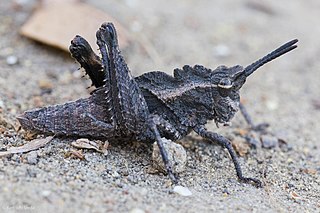 W
WDracotettix is a genus of dragon lubbers in the family Romaleidae. There are at least three described species in Dracotettix.
 W
WDracotettix monstrosus, the gray dragon lubber, is a species of lubber grasshopper in the family Romaleidae. It is found in North America.
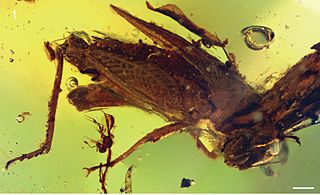 W
WElectrotettix is an extinct genus of pygmy locust found in amber collected in the Dominican Republic. Represented by a single species, Electrotettix attenboroughi, which lived 18-20 million years ago, it fed primarily on moss, fungi, and algae. The genus name is derived from electrum, Latin for "amber", and Greek tettix, meaning "grasshopper". The species was named after Sir David Attenborough. The female measures 8 millimeters in length: the male is unknown. The species is distinguished from modern members of the Cladonotinae subfamily by the fact that it retains vestigial wings, a feature lost somewhere between the ancient specimens and more modern species. E. attenboroughi was identified from a collection of amber at the Illinois Natural History Survey, which had been stored in a cabinet under a sink since it was collected in the 1950s by entomologist Milton Sanderson.
 W
WEpisactidae is a family of grasshoppers in the order Orthoptera. There are about 19 genera and more than 60 described species in Episactidae, found in Central and South America, China, and Madagascar.
 W
WEumastacidae are a family of grasshoppers sometimes known as monkey- or matchstick grasshoppers. They usually have thin legs that are held folded at right angles to the body, sometimes close to the horizontal plane. Many species are wingless and the head is at an angle with the top of the head often jutting above the line of the thorax and abdomen. They have three segmented tarsi and have a short antenna with a knobby organ at the tip. They do not have a prosternal spine or tympanum. Most species are tropical and the diversity is greater in the Old World. They are considered primitive within the Orthoptera and feed on algae, ferns and gymnosperms, the more ancient plant groups.
 W
WEumigus is a genus of grasshoppers in the family Pamphagidae. There are about five described species in Eumigus, found in southern Europe and North Africa.
 W
WEunapiodes is a genus of grasshoppers in the family Pamphagidae. There are at least four described species in Eunapiodes, found in North Africa.
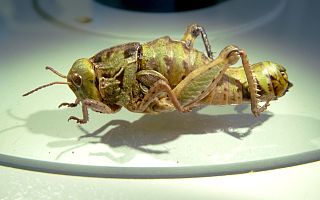 W
WEuryparyphes is a genus of grasshoppers in the family Pamphagidae. There are about 17 described species in Euryparyphes, found in southern Europe and North Africa.
 W
WLamarckiana is a genus of grasshoppers in the family Pamphagidae. There are about five described species in Lamarckiana, found in southern and eastern Africa.
 W
WLentula is a small genus of grasshoppers native to southern Africa. It is the type genus of the family Lentulidae.
 W
WLobosceliana is a genus of grasshoppers in the family Pamphagidae. There are about nine described species in Lobosceliana, found in southern Africa.
 W
WMorabidae is a family of grasshoppers in the order Orthoptera. There are more than 40 genera and 120 described species in Morabidae, found in Australasia.
 W
WNeotettix is a genus of pygmy grasshoppers in the family Tetrigidae. There are four described species in Neotettix: all from North America.
 W
WNeotridactylus apicialis, known generally as larger pygmy mole cricket, is a species of pygmy mole cricket in the family Tridactylidae. Other common names include the larger pygmy locust and larger sand cricket. It is found in North America and South America.
 W
WNocarodes is a genus of grasshoppers in the family Pamphagidae. There are at least 20 described species in Nocarodes, found in southeastern Europe and southwestern Asia.
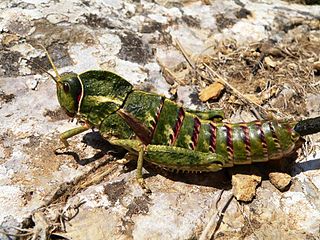 W
WPamphagus is a genus of grasshoppers in the family Pamphagidae. There are about 12 described species in Pamphagus, found in southern Europe and northern Africa.
 W
WParacinipe is a genus of grasshoppers in the family Pamphagidae. There are about 18 described species in Paracinipe, found in northern Africa and the Middle East.
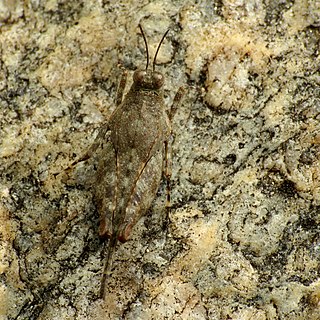 W
WParatettix aztecus, the Aztec pygmy grasshopper, is a species of pygmy grasshopper in the family Tetrigidae. It is found in Central America, North America, and South America.
 W
WParatettix cucullatus, the hooded grouse locust, is a species of pygmy grasshopper in the family Tetrigidae. It is found in North America.
 W
WParatettix mexicanus, the Mexican pygmy grasshopper, is a species of pygmy grasshopper in the family Tetrigidae. It is found in Central America and North America.
 W
WPetasida ephippigera is a pyrgomorph grasshopper, in the monotypic genus Petasida, native to tropical northern Australia. The species is named after Ludwig Leichhardt.
 W
WPhrynotettix is a genus of toad lubbers in the family Romaleidae. There are at least three described species in Phrynotettix.
 W
WPhyllochoreia is a genus of grasshopper endemic to the Western Ghats of India and Sri Lanka. It is in the family Chorotypidae of the superfamily Eumastacoidea.
 W
WPhymateus aegrotus, sometimes called the blue bush locust or East African bush locust, is a pest species of grasshopper in the family Pyrgomorphidae. Unlike "locusts" the adults are not known to change their morphology on crowding, but at the hopper stage, marching behaviour of small bands may occur.
 W
WPhymateus karschi is a locust in the family Pyrgomorphidae.
 W
WPhymateus viridipes, also known as the Green milkweed locust or African bush grasshopper, is an African locust in the family Pyrgomorphidae.
 W
WPlagiotriptus is a genus of thericleid orthopterans. It includes the following species:Plagiotriptus alca Plagiotriptus carli Plagiotriptus hippiscus Plagiotriptus leei Plagiotriptus loricatus Plagiotriptus parvulus Plagiotriptus peterseni Plagiotriptus pinivorus Plagiotriptus somalicus
 W
WPoekilocerus pictus is a large brightly coloured grasshopper found in the Indian subcontinent. Nymphs of the species are notorious for squirting a jet of liquid up to several inches away when grasped.
 W
WPrionotropis is a genus of grasshoppers in the family Pamphagidae. There are about nine described species in Prionotropis, found in southern Europe.
 W
WPseudoproscopia scabra, commonly known as the horsehead grasshopper, is a species of neotropical "stick grasshopper" of the family Proscopiidae. It is found in South America in Brazil, French Guiana, Venezuela and Peru.
 W
WPyrgomorpha conica is a species of pyrgomorph native to the Mediterranean Basin and Gran Canaria.
 W
WRomaleinae is a subfamily of lubber grasshoppers in the family Romaleidae, found in North and South America. There are more than 60 genera and 260 described species in Romaleinae.
 W
WSandgropers are wholly subterranean apterous insects of the family Cylindrachetidae that may grow up to 7 cm (3 in) long. Three genera are currently recognised: Cylindracheta, Cylindraustralia and Cylindroryctes. Like many subterranean animals, little is known about their habits and diet, but Western Australian farmers have blamed them for substantial crop losses.
 W
WScaria is a genus of groundhoppers or pygmy grasshoppers in the tribe Batrachideini from South America. There are about eight described species in Scaria.
 W
WSphenarium is a grasshoppers genus in the family Pyrgomorphidae indigenous to Mexico. Various species are caught and eaten as chapulines.
 W
WSphenarium purpurascens, is a grasshopper species in the genus Sphenarium found in Mexico and Guatemala.
 W
WTetrix arenosa, known generally as the obscure pygmy grasshopper or obscure grouse locust, is a species of pygmy grasshopper in the family Tetrigidae. It is found in North America.
 W
WTettigidea is a genus of groundhoppers or pygmy grasshoppers in the tribe Batrachideini from the Americas. There are at least 40 described species in Tettigidea.
 W
WTettigidea armata is a species in the family Tetrigidae, in the order Orthoptera. The species is known generally as the "armored pygmy grasshopper", "armoured grouse locust", or "spined grouse locust". It is found in North America.
 W
WTettigidea lateralis, known generally as black-sided pygmy grasshopper, is a species of pygmy grasshopper in the family Tetrigidae. Other common names include the black-sided grouse locust and sedge grouse locust. It is found in the Caribbean Sea, North America, and the Caribbean.
 W
WTitanacris albipes is a species of grasshopper in the family Romaleidae.
 W
WTrachypetrella is a genus of grasshoppers in the family Pamphagidae. There is one described species in Trachypetrella, T. anderssonii, found in southern Africa.
 W
WTropidacris is a genus of grasshopper in the family Romaleidae. Species within this genus are present in Central and Southern America. They are among the largest grasshoppers in the world by length and wingspan, reaching up to 12 cm (4.7 in) and 23 cm (9.1 in) respectively.
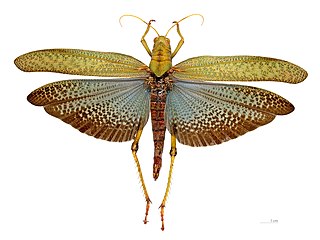 W
WTropidacris collaris is a species of grasshopper in the family Romaleidae. A large South American grasshopper, it is also known as the blue-winged grasshopper although they vary greatly in coloration. It is common in both forests and dry areas of South America from Colombia to Argentina. In parts of northern Argentina, they are considered a pest. They are also popular among insect and terrarium enthusiasts.
 W
WTropidacris cristata, the giant red-winged grasshopper, is a species of lubber grasshopper in the family Romaleidae.
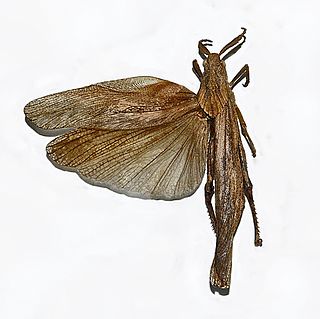 W
WXiphoceriana is a genus of grasshoppers belonging to the family Pamphagidae.
 W
WXiphoceriana atrox is a species of grasshoppers belonging to the family Pamphagidae.